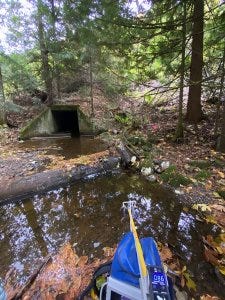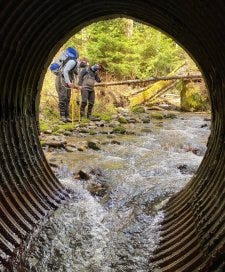Salmon are finding their way up new road culverts in Washington state that are meant to restore the endangered fish’s populations.
Two species of salmon and two species of trout are now able to travel further up Padden Creek past Interstate 5, possibly for the first time in decades, after a new culvert was built under the highway, scientists showed through environmental DNA sampling.
Scientists hunting eDNA for 18 months before, during and after the culvert replacement project say the new structure produced “a large impact on fish passage.”

Tracking eDNA is less time consuming than trapping and monitoring fish and is an effective way of knowing whether these projects are achieving their intended goals, scientists say.
“This kind of sampling is really powerful because the fish can hide, but the DNA can’t,” said Ryan Kelly, professor of Marine and Environmental Affairs at University of Washington and director of the eDNA Collaborative. “It’s like we’re detectives out there, pulling information out of the water about what lives where. For evaluating salmon passability in road culverts, it could be a game-changer because eDNA methods are massively scalable, and we’ve shown they work.”
Two culverts were replaced along Padden Creek, which connects Lake Padden with Bellingham Bay. Four species of fish — cutthroat trout, rainbow trout, coho salmon, and sockeye salmon — were provided access to another three miles of creek as a result of the new culvert under Interstate 5, according to Washington Department of Transportation. The highway was built in the 1960s.

A second culvert they sampled for eDNA “seemed to have no impact,” according to Kelly’s study, which he co-authored with Elizabeth Andruszkiewicz Allan, Erin D’Agnese, Maya Garber-Yonts, Megan Shaffer, Zachary Gold, and Andrew Shelton.
Fish leave behind environmental DNA floating in streams via scales, waste or decomposing flesh, which scientists pick up with specialized sampling equipment.
The team is hopeful eDNA testing technology will help transportation departments everywhere prioritize which rivers most need upgrades to their road passageways.
“We demonstrate a rigorous, quantitative method for environmental-impact reporting using eDNA that is widely applicable in environments worldwide,” the study concludes.
“It could be a game-changer because eDNA methods are massively scalable.”
Ryan Kelly, eDNA Collaborative
Washington state is mandated to improve fish passage at 900 culverts across its highway system as a result of a lawsuit successfully brought by Native American tribes asserting their fishing rights dating back to 1850s treaties with the federal government. The 17-year legal battle was ultimately decided by a split vote of the U.S. Supreme Court (United States v. Washington).
Fourteen populations of Washington salmon are listed as endangered under the U.S. federal Endangered Species Act. Some populations are bouncing back as a result of restoration and protection measures, while some are still struggling.
The fish play a large part in Pacific Northwest tribal culture and diet. They sustain human economies and fisheries from Alaska to California in the U.S. (not to mention Canada, Japan, Norway, and Russia). And, they are an important source of sustenance for wildlife like orcas and seals.
Salmon also bring ocean nutrients onto land. Their bodies are hauled from streams onto land by bears and birds of prey. Salmon-derived nutrients have been detected in stream-side trees shrubs, mosses and animals using carbon isotope analysis.
Hundreds of culverts have already been replaced. The goal is to eliminate anything too high, too fast, or too shallow for the fish to swim up, with a price tag totaling over $3 billion. One new culvert at Siebert Creek on Highway 101 opened 34 miles of fish habitat, according to
DNA shows salmon using new Washington culvert appeared first on EARTH HOPE.






So glad I found this! This makes me so happy.